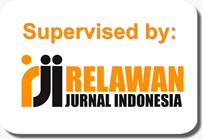THE INFLUENCE OF EDUCATIONAL SUPPORT ON ENTREPRENEURIAL INTEREST, FAMILY SUPPORT AS A MODERATOR VARIABLE ( RESEARCH ON ECONOMICS STUDENT OF BUNG HATTA)
Abstract
Key words: perceived educational support, perceived family support, entrepreneur intention
References
Adhitama, P.P. 2014. Faktor-faktor yang Mempengaruhi Minat Berwirausaha (Studi Kasus Mahasiswa Fakultas Ekonomika dan Bisnis UNDIP, Semarang). Skripsi. Fakultas Ekonomi UNDIP, Semarang
Cooper, D. R., & Schindler, P. S. 2011. Business Research Methods.11 ed. McGraw-Hill International Edition.
Davidsson, P. 1995. Determinants of entrepreneurial intentions. Rent IX. Workshop, Piacenza, Italy.
Farzier & Niehm, 2008. An assessment of the entrepreneurial intentions of college students majoring in Family and Consumer Sciences.
Ghozali, Imam. (2008). Structural Equation Modelling Metode Alternatif dengan Partial Least Square (PLS).Semarang: Badan Penerbit UniversitasDiponegoro.
Hair, J. F. Jr., Black, W. C., Babin, B. J., & Anderson, R. E. 2010.Multivariate data analysis. 7th ed. Upper Saddle River, NJ: Prentice Hall.
Hair, J., Hult, G., Ringle, C., & Sarstedt, M. (2014).A Primer on Partial Least Square Structural Equation Modelling (PLS-SEM). CA: Sage.
Hisrich, D.R & Peter, P.M (2002). Entrepreneurship. 5th Edition. Edition Mcgraw-Hill College
Kram, E.K 1983. Phases of the mentor relationship. The Academy of Management JournalVol. 26, No. 4 (Dec., 1983), pp. 608-625
Kourilsky, M.L. & Walstad, W.B. (1998). Entrepre-neurship and Female Youth: Knowledge, Attitudes, Gender Differences and Educational Practices. Journal of Business Venturing, 13(1): 77-88
Rogoff G & Heck. R.K.Z (2003). Evolving research in entrepreneurship and family business: Recognizing family as the oxygen that feeds the fire of entrepreneurship. Journal of Business Venturing, 18(5):559–566, 2003.
Shapero, A. and Sokol, L. (1982) The social dimensions of entrepreneurship. In C.Kent, D. Sexton and K. Vesper, (Eds.), Encyclopaedia of entrepreneurship, 72-90.
Suhartini, Y. 2001. “Analisis Faktor-faktor yang Mempengaruhi Minat Mahasiswa dalam berwiraswasta (Studi Pada Mahasiswa Univer-sitas PGRI Yogyakarta).” Jurnal Akmenika UPY, Volume 7, tahun 2011, pp: 38-59.
Turker, D.and Selcuk,S. (2008) in Turkey , “Which factors affect entrepreneurial intention of university students?”, in Turkey , Journal of European Industrial Training Vol. 33 No. 2, 2009 pp. 142-159, this journal is available at www.emeraldinsight.com/0309-0590.htm
Zimmerer, W.T. 2002.Essentials of Entrepreneurship and Small Business Management.Third Edition. New york: Prentice-Hall
DOI: https://doi.org/10.31846/jae.v6i3.89
Refbacks
- There are currently no refbacks.

This work is licensed under a Creative Commons Attribution-NonCommercial-NoDerivatives 4.0 International License.
e-Jurnal Apresiasi Ekonnomi Indexed by:












